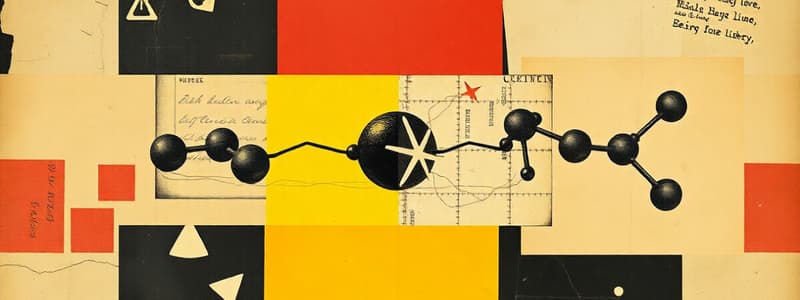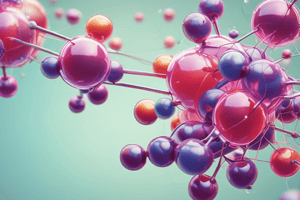Podcast
Questions and Answers
What is the definition of polarity?
What is the definition of polarity?
Equal or unequal sharing of electrons among atoms of molecules.
What is the octet rule?
What is the octet rule?
Atoms tend to gain, share, or transfer electrons in order to attain a stable 8 valence electrons.
What is electronegativity and how does electronegativity difference impact polarity?
What is electronegativity and how does electronegativity difference impact polarity?
The relative ability of an atom to draw electrons in a bond toward itself. The greater the electronegativity difference, the greater the polarity of the molecule.
Which of the following molecular geometries is always nonpolar?
Which of the following molecular geometries is always nonpolar?
Signup and view all the answers
What is viscosity?
What is viscosity?
Signup and view all the answers
What is surface tension?
What is surface tension?
Signup and view all the answers
What is capillarity?
What is capillarity?
Signup and view all the answers
Evaporation is an endothermic process.
Evaporation is an endothermic process.
Signup and view all the answers
Condensation is an exothermic process.
Condensation is an exothermic process.
Signup and view all the answers
What is vapor pressure?
What is vapor pressure?
Signup and view all the answers
What is the boiling point of a liquid?
What is the boiling point of a liquid?
Signup and view all the answers
The melting point and freezing point of a substance are the same temperature
The melting point and freezing point of a substance are the same temperature
Signup and view all the answers
What is the definition of specific heat?
What is the definition of specific heat?
Signup and view all the answers
What is heat of fusion?
What is heat of fusion?
Signup and view all the answers
What is heat of vaporization?
What is heat of vaporization?
Signup and view all the answers
What is heat of condensation?
What is heat of condensation?
Signup and view all the answers
What is a solution?
What is a solution?
Signup and view all the answers
Water is a good solvent because it is a polar molecule.
Water is a good solvent because it is a polar molecule.
Signup and view all the answers
What is the difference between a solute and a solvent?
What is the difference between a solute and a solvent?
Signup and view all the answers
What is a concentrated solution?
What is a concentrated solution?
Signup and view all the answers
What is a dilute solution?
What is a dilute solution?
Signup and view all the answers
What is an electrolyte?
What is an electrolyte?
Signup and view all the answers
What is an alloy?
What is an alloy?
Signup and view all the answers
What is the definition of mole fraction?
What is the definition of mole fraction?
Signup and view all the answers
What is the process of dilution?
What is the process of dilution?
Signup and view all the answers
What is solubility?
What is solubility?
Signup and view all the answers
What is an unsaturated solution?
What is an unsaturated solution?
Signup and view all the answers
Which of the following is a factor that affects the solubility of a solute?
Which of the following is a factor that affects the solubility of a solute?
Signup and view all the answers
Like dissolves like. So, a polar solvent dissolves a nonpolar solute.
Like dissolves like. So, a polar solvent dissolves a nonpolar solute.
Signup and view all the answers
The solubility of most solids in water increases with increasing temperature.
The solubility of most solids in water increases with increasing temperature.
Signup and view all the answers
The solubility of gases in water decreases with increasing temperature.
The solubility of gases in water decreases with increasing temperature.
Signup and view all the answers
The solubility of a gas in a liquid is directly proportional to the partial pressure of the gas over the solution according to Henry's Law.
The solubility of a gas in a liquid is directly proportional to the partial pressure of the gas over the solution according to Henry's Law.
Signup and view all the answers
Flashcards
Polarity
Polarity
The equal or unequal sharing of electrons among atoms in molecules.
Polar Molecule
Polar Molecule
A molecule with an unequal or asymmetrical distribution of electrons.
Nonpolar Molecule
Nonpolar Molecule
A molecule with equal or symmetrical distribution of electrons.
Octet Rule
Octet Rule
Signup and view all the flashcards
Electronegativity
Electronegativity
Signup and view all the flashcards
Intermolecular Forces
Intermolecular Forces
Signup and view all the flashcards
Viscosity
Viscosity
Signup and view all the flashcards
Surface Tension
Surface Tension
Signup and view all the flashcards
Capillarity
Capillarity
Signup and view all the flashcards
Evaporation
Evaporation
Signup and view all the flashcards
Boiling Point
Boiling Point
Signup and view all the flashcards
Hydrophilic
Hydrophilic
Signup and view all the flashcards
Hydrophobic
Hydrophobic
Signup and view all the flashcards
Saturated Solution
Saturated Solution
Signup and view all the flashcards
Supersaturated Solution
Supersaturated Solution
Signup and view all the flashcards
Molarity (M)
Molarity (M)
Signup and view all the flashcards
Molality (m)
Molality (m)
Signup and view all the flashcards
Dilution
Dilution
Signup and view all the flashcards
Phase Change
Phase Change
Signup and view all the flashcards
Thermal Expansion
Thermal Expansion
Signup and view all the flashcards
Specific Heat
Specific Heat
Signup and view all the flashcards
Heat of Fusion
Heat of Fusion
Signup and view all the flashcards
Heat of Vaporization
Heat of Vaporization
Signup and view all the flashcards
Cohesion
Cohesion
Signup and view all the flashcards
Adhesion
Adhesion
Signup and view all the flashcards
Diatomic Molecule
Diatomic Molecule
Signup and view all the flashcards
Colloid
Colloid
Signup and view all the flashcards
Suspension
Suspension
Signup and view all the flashcards
Electrolyte
Electrolyte
Signup and view all the flashcards
Neutralization
Neutralization
Signup and view all the flashcards
Allotropes
Allotropes
Signup and view all the flashcards
Unit Cell
Unit Cell
Signup and view all the flashcards
Study Notes
General Chemistry Study Notes
- Topic Overview: Good study habits and positive thinking are crucial for success. Avoid negativity.
Polarity of Molecules
-
Polarity: Unequal sharing of electrons between atoms in a molecule due to electronegativity differences creates partial positive and negative charges.
-
Polar Molecule: Molecules with uneven electron distribution. Asymmetrical distribution of electrons leads to partial charges. This arises from differences in electronegativity between the atoms and the molecule's geometry.
-
Nonpolar Molecule: Equal sharing of electrons among atoms, no partial charges, symmetrical electron distribution.
-
Electro-negativity: An atom's ability to attract bonding electrons. Higher difference in electronegativity between bonded atoms, greater polarity
-
Molecular Geometry: The arrangement of atoms in a molecule affects polarity. Linear, trigonal planar, tetrahedral, trigonal pyramidal, bent.
Intermolecular Forces
- Intermolecular forces (IMFs): Attractive forces between molecules. Weaker than intramolecular forces (bonds). Influence physical properties like boiling and melting points, viscosity, and solubility.
Types of Intermolecular Forces
-
London Dispersion Forces (LDF): Weakest IMF, present in all molecules, temporary dipoles due to electron movement. Strength increases with more electrons.
-
Dipole-dipole Forces: Polar molecules have partial charges and attract one another. Positive end of one to negative end of another. Strength increases with greater polarity.
-
Hydrogen Bonds: Strongest IMF, a special type of dipole-dipole force, occurs when hydrogen is bonded to a highly electronegative atom (F, O, or N). Highly polar.
Properties of Liquids
-
Viscosity: Resistance of a liquid to flow, related to IMFs. Higher IMFs, higher viscosity. Affected by temperature, Viscosity decreases with increasing temperature.
-
Surface tension: Tendency of liquids to minimize surface area. Inward force from stronger IMF in interior molecules causing surface molecules to pack closely
-
Capillarity: Spontaneous rising of a liquid in a narrow tube, due to cohesive and adhesive forces.
Phase Change
-
Endothermic: Process that absorbs heat from the surroundings.
-
Exothermic: Process that releases heat to the surroundings.
-
Evaporation/Vaporization: Liquid to gas. Kinetic energy overcomes attraction.
-
Condensation: Gas to liquid. Decreased kinetic energy, stronger attraction.
-
Sublimation: Solid to gas (skipping liquid). Weak attraction forces.
-
Melting: Solid to liquid. kinetic energy overcomes forces.
-
Freezing: Liquid to solid. Decreased kinetic energy, stronger attraction forces.
-
Deposition: Gas to solid. Reverse sublimation.
-
Phase Changes and Temperature: Temperature remains constant during phase changes, while energy is being absorbed or released.
Solutions overview
-
Solutions: Homogeneous mixtures Composed of a solute and a solvent
-
Concentrated solutions: higher amount of solute present than a dilute solutions
-
Solubility: The maximum amount of solute that can dissolve in a given amount of solvent, at a specified temperature
-
Unsaturated Solutions Contain less solute than solvent can dissolve
-
Saturated Solutions: Contain the maximum amount of dissolved solute at a given temperature, no more solute will dissolve
-
Supersaturated Solutions: Contain more solute than a saturated solution at a given temperature.
-
Factors affecting solubility: The nature of solute/solvent. Temperature. Pressure. "Like dissolves like".
Specific Heat
-
Specific Heat: Heat needed to raise the temperature of 1 gram of a substance by 1°C.
-
Heat of Fusion: Energy needed to melt one gram of a solid at its melting point.
-
Heat of Vaporization: Energy needed to convert one gram of a liquid to a gas at its boiling point
-
Heat of Sodification: The amount of energy released when 1 gram of a liquid changes to 1 gram of a solid at the freezing point.
-
Heat of Condensation: The amount of energy released when 1 gram of a gas changes to 1 gram of a liquid
Studying That Suits You
Use AI to generate personalized quizzes and flashcards to suit your learning preferences.
Related Documents
Description
This quiz focuses on the polarity of molecules in chemistry, covering essential concepts such as polar and nonpolar molecules, electronegativity, and molecular geometry. Understanding these principles is vital for grasping how molecular structure influences chemical behavior.




